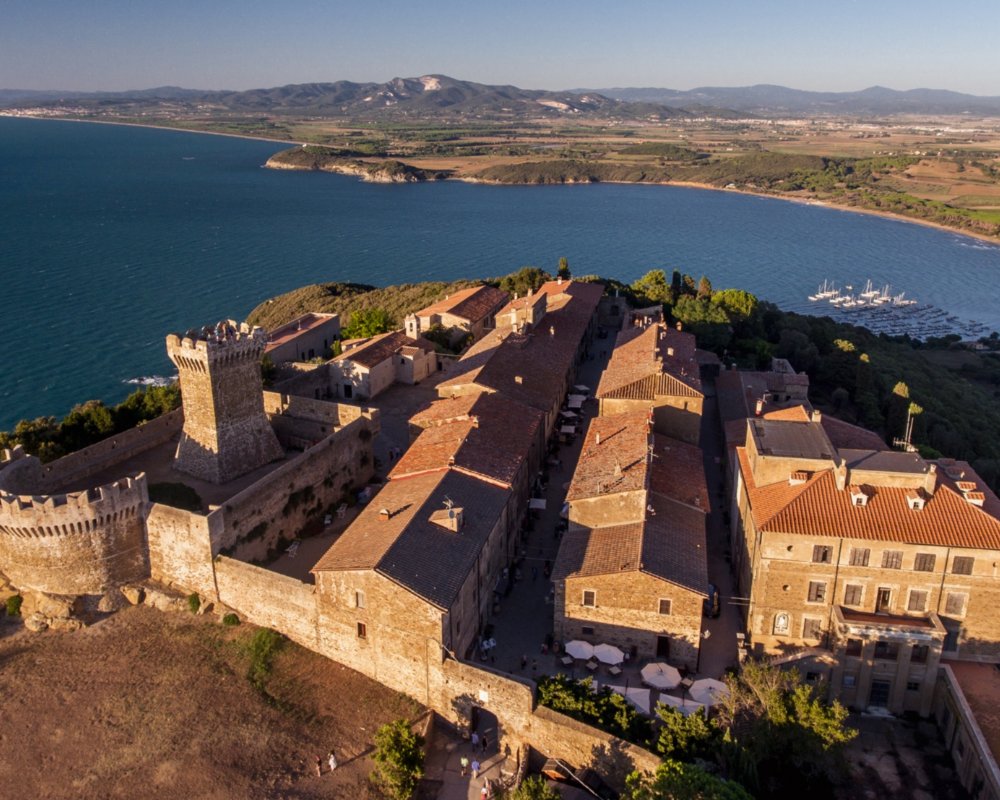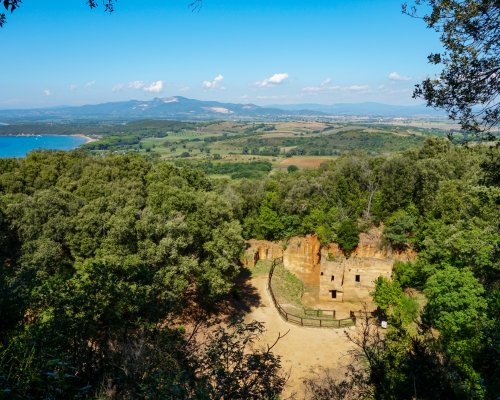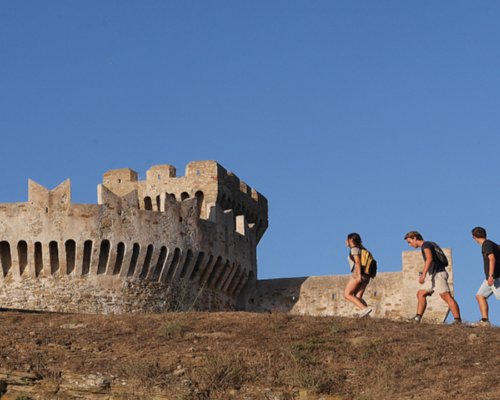Three days of archaeology, bays and parks in southern Tuscany
Traces of the ancient and mysterious Etruscan civilization can be found all throughout Tuscany, but nowhere are they better seen than on the Etruscan Coast, running from Castiglioncello all the way down to Piombino. Here, you can find millennia-old tombs, archaeology museums and parks and kilometres of gorgeous shoreline.
If you’re looking for a holiday off the beaten track, following in the footsteps of these powerful and enigmatic peoples, check out our tips for three days of history and nature.
Pour l'essentiel d'un séjour de six jours ou d'une semaine dans la région, Piombino constitue un excellent point de départ. Ville portuaire animée, la deuxième de Toscane après Livourne en termes d'activité, la ville a une histoire impressionnante en tant qu'ancienne capitale de la Principauté de Piombino, un État indépendant entre les XVe et le XVIe siècles. Mais sa gloire remonte jusqu’à l'époque étrusque, évidente à presque chaque tournant, bien qu'aujourd'hui elle soit plus connue pour être un centre titanesque de l'industrie sidérurgique italienne.
Pour commencer, rendez-vous au Château de Piombino à l'extrémité sud-est de la ville. Ancienne structure défensive, il marquait les limites sud-est de la ville, mais on en savait très peu jusqu'au début du XXIe siècle. Entre 1999 et 2001, des fouilles et des projets de recherche ont été menés sur place. Aujourd'hui, le château abrite un musée civique qui brosse un portrait vivant de Piombino au fil des ans, en plus d'abriter de nombreux objets du XIIIe siècle découverts lors des fouilles archéologiques de la région.
Si vous avez envie de quelque chose de plus actuel qu'une antiquité, visitez la centre-ville avec les expositions temporaires de la Galerie Agorà, qui accueille régulièrement des œuvres d'artistes internationaux.
Pour l'essentiel d'un séjour de six jours ou d'une semaine dans la région, Piombino constitue un excellent point de départ. Ville portuaire animée, la deuxième de Toscane après Livourne en termes d'activité, la ville a une histoire impressionnante en tant qu'ancienne capitale de la Principauté de Piombino, un État indépendant entre les XVe et le XVIe siècles. Mais sa gloire remonte jusqu’à l'époque étrusque, évidente à presque chaque tournant, bien qu'aujourd'hui elle soit plus connue pour être un centre titanesque de l'industrie sidérurgique italienne.
Pour commencer, rendez-vous au Château de Piombino à l'extrémité sud-est de la ville. Ancienne structure défensive, il marquait les limites sud-est de la ville, mais on en savait très peu jusqu'au début du XXIe siècle. Entre 1999 et 2001, des fouilles et des projets de recherche ont été menés sur place. Aujourd'hui, le château abrite un musée civique qui brosse un portrait vivant de Piombino au fil des ans, en plus d'abriter de nombreux objets du XIIIe siècle découverts lors des fouilles archéologiques de la région.
Si vous avez envie de quelque chose de plus actuel qu'une antiquité, visitez la centre-ville avec les expositions temporaires de la Galerie Agorà, qui accueille régulièrement des œuvres d'artistes internationaux.
Profitez du deuxième jour pour vous plonger dans la civilisation étrusque à Populonia, une fraction de Piombino qui ne compte qu'un petit nombre de résidents. Le village se trouve à vingt minutes de route et s'incline vers la saisissante baie de Baratti. À l'époque étrusque, c’était un centre important, connu sous le nom de « Fufluna » (du nom de Fufluns, le dieu étrusque du vin) et, alternativement, de Pupluna.
Les vestiges et les nécropoles de cette civilisation autrefois glorieuse peuvent être mieux compris en compagnie d'un guide expérimenté. Pour avoir une idée plus complète de ce qu'était la vie des Étrusques sur la côte, prévoyez de vous rendre au Parc Archéologique de Baratti et Populonia.
Le Musée Étrusque de Populonia, qui abrite une fascinante collection d'accessoires funéraires, de décorations tombales et de reliques récupérées dans la mer, vous permettra d'assimiler ce que vous avez appris sur place.
Avancez de quelques siècles jusqu'à la Tour de Populonia, datant du XIIIe siècle et relativement « récente » : ce poste stratégique était le lieu où les défenseurs de la ville montaient la garde. Aujourd'hui, elle offre une vue imprenable sur l'Île d'Elbe, les différentes îles de l'archipel toscan, la Baie de Baratti et l'ensemble du Val di Cornia.
Profitez du deuxième jour pour vous plonger dans la civilisation étrusque à Populonia, une fraction de Piombino qui ne compte qu'un petit nombre de résidents. Le village se trouve à vingt minutes de route et s'incline vers la saisissante baie de Baratti. À l'époque étrusque, c’était un centre important, connu sous le nom de « Fufluna » (du nom de Fufluns, le dieu étrusque du vin) et, alternativement, de Pupluna.
Les vestiges et les nécropoles de cette civilisation autrefois glorieuse peuvent être mieux compris en compagnie d'un guide expérimenté. Pour avoir une idée plus complète de ce qu'était la vie des Étrusques sur la côte, prévoyez de vous rendre au Parc Archéologique de Baratti et Populonia.
Le Musée Étrusque de Populonia, qui abrite une fascinante collection d'accessoires funéraires, de décorations tombales et de reliques récupérées dans la mer, vous permettra d'assimiler ce que vous avez appris sur place.
Avancez de quelques siècles jusqu'à la Tour de Populonia, datant du XIIIe siècle et relativement « récente » : ce poste stratégique était le lieu où les défenseurs de la ville montaient la garde. Aujourd'hui, elle offre une vue imprenable sur l'Île d'Elbe, les différentes îles de l'archipel toscan, la Baie de Baratti et l'ensemble du Val di Cornia.
After breakfast in Bolgheri, set off for the delightful medieval town of Bibbona, which dates to the Villanovan era and was later inhabited by the Etruscans. The town centre is made of small winding medieval streets and piazzas, and a stand-out stop is the Renaissance Church of Santa Maria della Pietà, which houses some exquisite 17th-century marble ornaments and a beautiful 14th-century Pietà.
Continue to the popular Marina di Bibbona, where the long sandy beaches and enchanting pine forest provide the perfect place to unwind in beautiful surroundings. For true nature aficionados, the Macchia della Magone, a magical, protected woodland area, is a must-see. It boasts 17 different itineraries for lovers of hiking, horse-riding or cycling, surrounded by lush Tuscan vegetation and a huge variety of tree and animal species. If cycling in these breath-taking surroundings takes your fancy, there are some fantastic routes through the hills or along the coast, such as the Gran Fondo Costa degli Etruschi.
The town of Cecina is nestled between the rolling Tuscan countryside and the Etruscan coast, and has a dense pinewood bordering 15 kilometres of beach, which also provides the perfect location for a spot of walking or cycling. Combine an outdoor excursion with a trip to the Guerrazzi Museum to get your fill of Etruscan and Roman artefacts and to the Roman settlement of Villa di San Vincenzino, which was excavated in the 1960s and 80s and provides an interesting insight into Roman civilisation in this area. Good food is also important in this area and there are a number of cultural events that take place here during the year.
As the sun begins to set, make your way to the Rosignano Marittimo area, and the old Etruscan town of Castiglioncello. Set upon a sweeping bay, Castiglioncello has inspired generations of artists and boasts a thriving cultural scene, as well as an awe-inspiring stretch of coastline. There are a variety of accommodation options here and a number of restaurants where you can enjoy a fresh catch of the day. It is also home to the National Archaeological Museum, an important archaeological area discovered in the first decade of the 20th century.
The Etruscans left important traces in the Rosignano Marittimo area, as seen in the burial grounds unearthed in Castiglioncello, Rosignano Solvay, Vada and Castelnuovo della Misericordia. Castiglionello and the nearby bays of Chieco and Rosignano Solvay also provide an array of water sports opportunities and diving for those who want to get closer to rich seabeds along this stretch of coastline.
After breakfast in Bolgheri, set off for the delightful medieval town of Bibbona, which dates to the Villanovan era and was later inhabited by the Etruscans. The town centre is made of small winding medieval streets and piazzas, and a stand-out stop is the Renaissance Church of Santa Maria della Pietà, which houses some exquisite 17th-century marble ornaments and a beautiful 14th-century Pietà.
Continue to the popular Marina di Bibbona, where the long sandy beaches and enchanting pine forest provide the perfect place to unwind in beautiful surroundings. For true nature aficionados, the Macchia della Magone, a magical, protected woodland area, is a must-see. It boasts 17 different itineraries for lovers of hiking, horse-riding or cycling, surrounded by lush Tuscan vegetation and a huge variety of tree and animal species. If cycling in these breath-taking surroundings takes your fancy, there are some fantastic routes through the hills or along the coast, such as the Gran Fondo Costa degli Etruschi.
The town of Cecina is nestled between the rolling Tuscan countryside and the Etruscan coast, and has a dense pinewood bordering 15 kilometres of beach, which also provides the perfect location for a spot of walking or cycling. Combine an outdoor excursion with a trip to the Guerrazzi Museum to get your fill of Etruscan and Roman artefacts and to the Roman settlement of Villa di San Vincenzino, which was excavated in the 1960s and 80s and provides an interesting insight into Roman civilisation in this area. Good food is also important in this area and there are a number of cultural events that take place here during the year.
As the sun begins to set, make your way to the Rosignano Marittimo area, and the old Etruscan town of Castiglioncello. Set upon a sweeping bay, Castiglioncello has inspired generations of artists and boasts a thriving cultural scene, as well as an awe-inspiring stretch of coastline. There are a variety of accommodation options here and a number of restaurants where you can enjoy a fresh catch of the day. It is also home to the National Archaeological Museum, an important archaeological area discovered in the first decade of the 20th century.
The Etruscans left important traces in the Rosignano Marittimo area, as seen in the burial grounds unearthed in Castiglioncello, Rosignano Solvay, Vada and Castelnuovo della Misericordia. Castiglionello and the nearby bays of Chieco and Rosignano Solvay also provide an array of water sports opportunities and diving for those who want to get closer to rich seabeds along this stretch of coastline.


